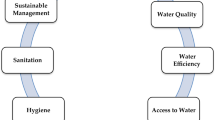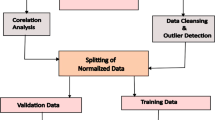Abstract
Ensuring drinking water safety is crucial for maintaining public health and preventing waterborne diseases. To ensure clean and safe drinking water for all, it is vital to continuously monitor, treat, and adhere to quality standards. We specifically designed and developed a hybrid model to predict water drinkability accurately by analyzing diverse chemical contaminants, making a significant contribution to our objective. The hybrid model will help the water supply department to ensure the water quality before supply and this way water safety will be ensured. Substantial advancements have been made across various datasets and enhanced our infrastructure to develop a sophisticated machine learning model for assessing the quality of drinking water. The model is developed based on meta-learning and few-shot learning and then some machine learning models are applied to define the success of our model. The maximum accuracy was found to be 98% using the proposed model.
Access this chapter
Tax calculation will be finalised at checkout
Purchases are for personal use only
Similar content being viewed by others
References
Anik AH, Sultan MB, Alam M, Parvin F, Ali MM, Tareq SM (2023) The impact of climate change on water resources and associated health risks in Bangladesh: a review. Water Secur 18:100133. https://doi.org/10.1016/J.WASEC.2023.100133
Emmanuel E, Pierre MG, Perrodin Y (2009) Groundwater contamination by microbiological and chemical substances released from hospital wastewater: health risk assessment for drinking water consumers. Environ Int 35(4):718–726. https://doi.org/10.1016/j.envint.2009.01.011
Najah Ahmed A et al (2019) Machine learning methods for better water quality prediction. J Hydrol 578. https://doi.org/10.1016/j.jhydrol.2019.124084
Wang S, Peng H, Liang S (2022) Prediction of estuarine water quality using interpretable machine learning approach. J Hydrol 605. https://doi.org/10.1016/j.jhydrol.2021.127320
Patel J et al (2022) A machine learning-based water potability prediction model by using synthetic minority oversampling technique and explainable AI. Comput Intell Neurosci 2022:9283293. https://doi.org/10.1155/2022/9283293
Pacheco L, Kaddoura S (2022) Evaluation of machine learning algorithm on drinking water quality for better sustainability. Sustainable 14(18):11478. https://doi.org/10.3390/SU141811478
Dogo EM, Nwulu NI, Twala B, Aigbavboa C (2019) A survey of machine learning methods applied to anomaly detection on drinking-water quality data. Urban Water J 16(3):235–248. https://doi.org/10.1080/1573062X.2019.1637002
Hu XC, Dai M, Sun JM, Sunderland EM (2023) The utility of machine learning models for predicting chemical contaminants in drinking water: promise, challenges, and opportunities. Curr Environ Heal Rep 10(1):45–60. https://doi.org/10.1007/s40572-022-00389-x
Ajayi OO, Bagula AB, Maluleke HC, Gaffoor Z, Jovanovic N, Pietersen KC (2022) WaterNet: a network for monitoring and assessing water quality for drinking and irrigation purposes. IEEE Access 10:48318–48337. https://doi.org/10.1109/ACCESS.2022.3172274
Decuyper M, Stockhoff M, Al Vandenberghe S, Ying X (2019) An overview of overfitting and its solutions. J Phys Conf Ser 1168(2):022022. https://doi.org/10.1088/1742-6596/1168/2/022022
Wang JX (2021) Meta-learning in natural and artificial intelligence. Curr Opin Behav Sci 38:90–95. https://doi.org/10.1016/J.COBEHA.2021.01.002
Meta-Learning Is All You Need—James Le. https://jameskle.com/writes/meta-learning-is-all-you-need. Accessed 19 May 2023
Peng H (2023) A comprehensive overview and survey of recent advances in meta-learning. https://arxiv.org/abs/2004.11149v7. Accessed 19 May 2023
Author information
Authors and Affiliations
Corresponding author
Editor information
Editors and Affiliations
Rights and permissions
Copyright information
© 2024 The Author(s), under exclusive license to Springer Nature Switzerland AG
About this paper
Cite this paper
Moheuddin, M.S. et al. (2024). Machine Learning Model to Define Water Potability Considering Distinctive Chemical Contaminants. In: Vasant, P., et al. Intelligent Computing and Optimization. ICO 2023. Lecture Notes in Networks and Systems, vol 1167. Springer, Cham. https://doi.org/10.1007/978-3-031-73318-5_3
Download citation
DOI: https://doi.org/10.1007/978-3-031-73318-5_3
Published:
Publisher Name: Springer, Cham
Print ISBN: 978-3-031-73317-8
Online ISBN: 978-3-031-73318-5
eBook Packages: Intelligent Technologies and RoboticsIntelligent Technologies and Robotics (R0)




